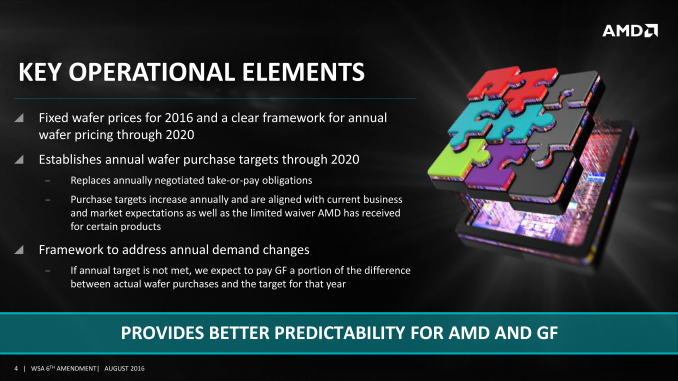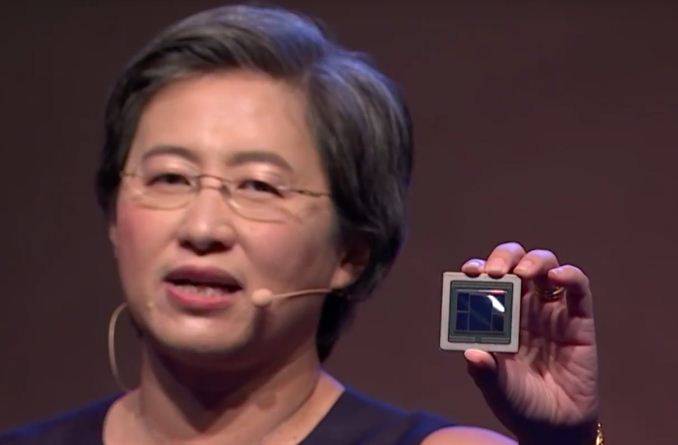AMD's 7nm CPUs & GPUs To Be Fabbed by TSMC, on Track for 2018 - 2019
by Ryan Smith & Anton Shilov on August 27, 2018 6:40 PM EST- Posted in
- Semiconductors
- CPUs
- AMD
- GlobalFoundries
- GPUs
- TSMC
- Vega
- Navi
- Zen 2

With the announcement that its long-time manufacturing partner (and outright former fab) GlobalFoundries is dropping out of the race for bleeding-edge manufacturing nodes, the second big question of the day has been what this means for AMD. For all intents and purposes, AMD and GlobalFoundries have been tied at the hip since GloFo was spun off from AMD back in 2009, and consequently GloFo has always been AMD’s fab of choice for CPUs, and more recently GPUs. So with GlobalFoundries’ changes to their process development plans, AMD is outlining their new partnerships and manufacturing plans.
In short, AMD is now shifting over the bulk of their bleeding-edge development to TSMC. The company is careful to note that they “intend to focus the breadth” of their 7nm production at TSMC rather than all 7nm production – leaving open the possibility of using TSMC rival Samsung in the future – but the message is clear that we should expect AMD’s major 7nm products to be fabbed out of TSMC now that GlobalFoundries is no longer an option.
TSMC being AMD’s new bleeding-edge partner should of course come as no surprise, as TSMC has been the fab AMD has fallen back on for other projects in the past. TSMC was until the most recent generation the fab AMD used for their GPUs, and it’s where their semi-custom APUs for Microsoft and Sony have been made. Meanwhile AMD and TSMC have already previously announced that some of AMD’s forthcoming 7nm products, including their 7nm Vega and “Rome” EPYC CPU would be fabbed by the Taiwanese foundry. So today’s announcement is largely confirmation that AMD is going to continue down this path, with most (if not all) of their other planned 7nm products ending up at TSMC as well.
As it stands then, AMD’s plans remain largely unchanged. AMD’s 7nm Vega GPU has been successfully taped out, and it is currently sampling among AMD’s customers with a commercial launch towards the end of this year. Then in 2019, AMD intends to release its CPUs featuring its Zen 2 microarchitecture. These processors will also be fabbed by TSMC and the chip designer has already received the first working silicon.
Farther out, AMD’s announcement also confirms that their upcoming Navi architecture GPUs, which are also planned for 7nm, will be fabbed at TSMC. Though AMD has not disclosed any timeframes regarding these GPUs and whether any of them have been taped out.
Overall, AMD seems reasonably happy with the current state of affairs, stating that “Our work with TSMC on their 7nm node has gone very well and we have seen excellent results from early silicon.” As a close GlobalFoundries customer, I have to imagine that AMD was the first such customer informed of these plans, so they’ve had the most time to adjust their internal plans. None the less, the company sees it as win for their “flexible foundry” strategy, and as a result, they do not expect any changes to their product roadmaps despite the foundry changes.
That said, while AMD seems to be handling this well, this isn’t a feint on their part, and that they’ve had to make changes behind the scenes. The company has confirmed to us that they had started development of a chip to be made using GlobalFoundries' 7LP process technology, but this one had not been taped out yet (it was on track for a Q4 tape out, according to GF). So we will be seeing products that weren’t originally intended for TSMC.
As for AMD’s GlobalFoundries relationship, the company will be continuing to work with GlobalFoundries for some time to come. GloFo is still AMD’s fab for their current Vega, Polaris, and Zen/Zen+ chips, and AMD will continue making chips there. Furthermore should AMD decide to start on any new chips that don’t require a bleeding-edge manufacturing process (e.g. a chipset), then GlobalFoundries is still an option.

To be renegotiated: AMD's most recent GF Wafer Share Agreement
The biggest remaining question then will be what this means for AMD and GlobalFoundries longstanding Wafer Share Agreement (WSA), which has kept the two companies bound together tightly and required that AMD do most of its manufacturing at their former fab. Today’s announcement from GlobalFoundries and AMD has confirmed that the two companies will be renegotiating the WSA – presumably a requirement should GloFo no longer intend to offer bleeding-edge nodes – though to what extent remains to be seen. AMD by their own admittance is betting very heavily on 7nm products, so it’s not clear whether the company is going to need all that many wafers from GlobalFoundries in a couple years’ time. In the meantime, AMD does not believe it is going to need any WSA with TSMC.
Related Reading:
- GlobalFoundries Stops All 7nm Development: Opts To Focus on Specialized Processes
- AMD “Rome” EPYC CPUs to Be Fabbed By TSMC
- AMD Demos 7nm Vega GPU: Betting Big on Machine Learning for Radeon Instinct; Shipping This Year
- The AMD Threadripper 2990WX 32-Core and 2950X 16-Core Review
- More Details About the ZhongShan Subor Z+ Console, with Custom AMD Ryzen SoC
- The AMD 2nd Gen Ryzen Deep Dive: The 2700X, 2700, 2600X, and 2600 Tested
Source: AMD











28 Comments
View All Comments
Duncan Macdonald - Tuesday, August 28, 2018 - link
Two things 1) As GF abandoned 7nm would AMD still be liable to penalty payments under the WSA?2) Chipsets do not need 7nm and can still be produced at GF
beginner99 - Tuesday, August 28, 2018 - link
I hope this contract contained paragraphs for this kind of thins also like sunken dev costs. I mean a chip that was to tape out soon already cost double digits in millions. Will GF pay that back?And AFAIK back in the day it was clear the WSA was only valid as long as GF is offering competitive performance / nodes. So maybe this could be a hug ewin for AMD getting rid of the WSA.
Also how IBM will react? IBM is huge and has huge funds so that will probably be a long and dirty legal battle. After all power cpus really heavily on high clocks and they had a deal that GF develops a process just fro IBM...Can they just toss that in the trash without serious legal or monetary consequences? doubtful.
jjj - Tuesday, August 28, 2018 - link
This could be both good and bad news for AMD.It could allow them to launch Ryzen with Zen 2 sooner but the big question is how it clocks. They need 5GHz+ not 4GHz, can they achieve that at TSMC?
NeuralNexus - Tuesday, August 28, 2018 - link
What makes you believe that AMD needs to hit 5Ghz on Zen 2 parts when they have the IPC advantage over INTEL right now? INTEL over advantages is frequency, they can't really gain more IPC out of their refined stagnate architecture.HStewart - Tuesday, August 28, 2018 - link
I think they are finding out the same troubles that Intel found out with 10nm - but keep in mind in Intel calculations there 10nm is same as other 7nm. Keep in mind also it does not just the frequency or the number cores that matter, but what is under the hood. I believe with later Intel CPU's they found they can get more performance in same process.enzotiger - Tuesday, August 28, 2018 - link
Any data to support your claim that AMD has better IPC?0ldman79 - Wednesday, August 29, 2018 - link
I try to remain objective externally, but internally I'm an AMD guy, pulling for the underdog.That being said, at best AMD matches Intel's IPC, they don't beat it.
Intel has a few differences in their integer setup and AVX processing that everyone is optimized for, runs right past AMD.
Now if AMD were optimized for it has a more powerful integer setup, though not necessarily faster.
I don't think it is the lithography that is limiting the clock speed. The FX and Sandy Bridge could hit 5GHz on 32nm. I've got an FX that can hit 5GHz any time I feel like it, chip can handle it all day long, though the motherboard can't.
Regardless, lets say that AMD has the IPC edge by 5%, Intel can put out a 5GHz CPU *today* and beat that. Intel actually could make a few changes to their "stagnate" architecture and push more out of it. It isn't stagnant, if you look back at the architecture this one begins with the Pentium Pro and has been refined and added to ever since. Honestly, Nehalem was a big difference from the Core 2, Sandy Bridge was a big departure from Nehalem, Haswell was a rather big jump from Sandy Bridge, though they haven't made huge changes since.
Sandy Bridge had enough changes made it could have been viewed as a different architecture and if you look at the entire line Intel has made huge changes in the Core ix lineup and kept the name. Previously architecture changes of that magnitude have warranted a new name. The PIII to Banias to Dothan realistically were more similar than the Nehalem to Sandy Bridge to Haswell.
Targon - Wednesday, August 29, 2018 - link
This is where third generation Ryzen comes into play. First generation Ryzen to second fixed some memory/cache related performance limitations, but not a lot of big design changes. The rumors are that third generation may provide a 10-15 percent IPC boost to Ryzen. If the jump to 7nm gets AMD to 5GHz, plus that IPC improvement, then AMD may very well have an IPC lead, and not much slower than what Intel chips can hit for clock speed. That is why the jump to 7nm is so important, because it has the potential to put AMD in the lead in single-threaded, as well as multi-threaded workloads.Targon - Wednesday, August 29, 2018 - link
The perception by many people is that clock speed is the one area that allows Intel to dominate in certain areas, such as gaming, and those single threaded benchmarks that don't really matter. If AMD is able to hit 5GHz, any advantage that Intel had in terms of performance would be gone, with the exception where extra memory channels come into play(since Ryzen branded products only have a dual-channel memory controller due to socket AM4).beginner99 - Tuesday, August 28, 2018 - link
Yeah. This killed the dream of a 5ghz zen2 on IBMs HPC process.